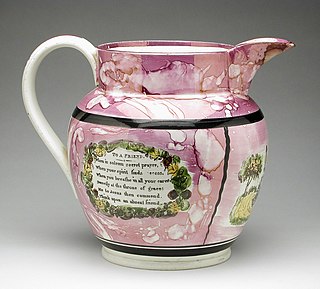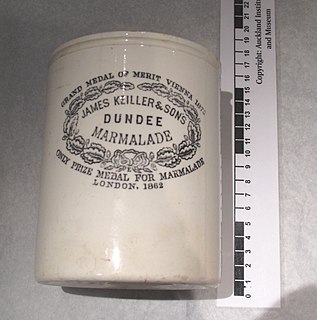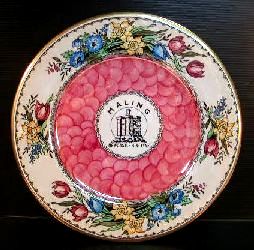
Clarice Cliff was an English ceramic artist and designer. Active from 1922-to 1963, Cliff became the head of the factory creative department.

Thomas Whieldon was a significant English potter who played a leading role in the development of Staffordshire pottery.

Hornsea Pottery was a business located in the coastal town of Hornsea in the East Riding of Yorkshire, England. They specialized in tableware with elegant contemporary designs.

Sunderland lustreware is a type of lustreware pottery made, mostly in the early 19th century, in several potteries around Sunderland, England.

Langley Mill Pottery was located in Langley Mill, Derbyshire on the Derbyshire – Nottinghamshire border. From its establishment in 1865 to its final closure in 1982, the pottery went through five distinct periods of ownership, producing a wide range of stoneware ranging from salt glazed ink bottles, utilitarian items and tableware to high quality and original art pottery.

Transfer printing is a method of decorating pottery or other materials using an engraved copper or steel plate from which a monochrome print on paper is taken which is then transferred by pressing onto the ceramic piece. Pottery decorated using the technique is known as transferware or transfer ware.

The Rockingham Pottery was a 19th-century manufacturer of porcelain of international repute, supplying fine wares and ornamental pieces to royalty and the aristocracy in Britain and overseas, as well as manufacturing porcelain and earthenware items for ordinary use.

Royal Doulton is an English ceramic and home accessories manufacturer that was founded in 1815. Operating originally in Vauxhall, London, and later moving to Lambeth, in 1882 it opened a factory in Burslem, Stoke-on-Trent, in the centre of English pottery. From the start, the backbone of the business was a wide range of utilitarian wares, mostly stonewares, including storage jars, tankards and the like, and later extending to pipes for drains, lavatories and other bathroom ceramics. From 1853 to 1901, its wares were marked Doulton & Co., then from 1901, when a royal warrant was given, Royal Doulton.

Mintons was a major company in Staffordshire pottery, "Europe's leading ceramic factory during the Victorian era", an independent business from 1793 to 1968. It was a leader in ceramic design, working in a number of different ceramic bodies, decorative techniques, and "a glorious pot-pourri of styles - Rococo shapes with Oriental motifs, Classical shapes with Medieval designs and Art Nouveau borders were among the many wonderful concoctions". As well as pottery vessels and sculptures, the firm was a leading manufacturer of tiles and other architectural ceramics, producing work for both the Houses of Parliament and United States Capitol.
Lorna Bailey is an English potter and businesswoman.

Keiller's marmalade is named after its creator James and Janet Keiller, and is believed to have been the first commercial brand of marmalade in Great Britain. It was made by James Keiller in Dundee, Scotland, later creating James Keiller & Son, a brand name which became iconic in the 18th and 19th centuries, and has been sold several times.

Blue Ridge is a brand and range of American tableware (dishware) manufactured by Southern Potteries Incorporated from the 1930s until 1957. Well known in their day for their underglaze decoration and colorful patterns, Blue Ridge pieces are now popular items with collectors of antique dishware. The underglaze technique made the decorations more durable, and while basic patterns were reused consistently, the fact that each piece was hand-painted means that no two pieces are exactly alike.

The Paragon China Company was a British manufacturer of bone china from 1919 to 1960, based in Longton, Stoke-on-Trent, previously known as the Star China Company, and more recently part of the Royal Doulton group. Paragon was noted for producing high quality teaware and tableware, and was granted royal warrants of appointment by several members of the British Royal Family.
Red Wing pottery refers to American stoneware, pottery, or dinnerware items made by a company initially set up in Red Wing, Minnesota, in 1861 by German immigrant John Paul, which changed its names several times until finally settling on Red Wing Potteries, Inc. in 1936. The pottery factory that started in 1861 continues to the present day under the names of Red Wing Pottery and Red Wing Stoneware. There was a respite in production when Red Wing Pottery Sales, Inc. had a strike in 1967 causing them to temporarily cease trading. The company still makes both zinc/Bristol glazed products as well as salt-glazed, hand-thrown, kiln fired items.

Art pottery is a term for pottery with artistic aspirations, made in relatively small quantities, mostly between about 1870 and 1930. Typically, sets of the usual tableware items are excluded from the term; instead the objects produced are mostly decorative vessels such as vases, jugs, bowls and the like which are sold singly. The term originated in the later 19th century, and is usually used only for pottery produced from that period onwards. It tends to be used for ceramics produced in factory conditions, but in relatively small quantities, using skilled workers, with at the least close supervision by a designer or some sort of artistic director. Studio pottery is a step up, supposed to be produced in even smaller quantities, with the hands-on participation of an artist-potter, who often performs all or most of the production stages. But the use of both terms can be elastic. Ceramic art is often a much wider term, covering all pottery that comes within the scope of art history, but "ceramic artist" is often used for hands-on artist potters in studio pottery.

Pacific Clay Products, founded 1892, was created by the merger of several Southern California potteries. The company began producing utilitarian pottery in the 1920s, and introduced solid color earthenware dinnerware in 1932. The primary site for the production of ceramic tableware, kitchenware, and art ware was based in the company's Lincoln Heights, Los Angeles plant at 306 West Avenue 26. Pacific Clay ceased production of ceramic dinnerware and art ware in 1942. After 1942, Pacific Clay produced sewer tile and brick. The company ceased production of sewer tile in 1997. The company continues to produce brick products in Lake Elsinore, California. The company has been owned by David H. Murdock since 1973.

North Shields Pottery was an English pottery manufacturer that created earthenware ceramics from circa 1814 to circa 1913 under a succession of owners and company names.

Ironstone china, ironstone ware or most commonly just ironstone, is a type of vitreous pottery first made in the United Kingdom in the early 19th century. It is often classed as earthenware although in appearance and properties it is similar to fine stoneware. It was developed in the 19th century by potters in Staffordshire, England, as a cheaper, mass-produced alternative for porcelain.

American art pottery refers to aesthetically distinctive hand-made ceramics in earthenware and stoneware from the period 1870-1950s. Ranging from tall vases to tiles, the work features original designs, simplified shapes, and experimental glazes and painting techniques. Stylistically, most of this work is affiliated with the modernizing Arts and Crafts (1880-1910), Art Nouveau (1890–1910), or Art Deco (1920s) movements, and also European art pottery.

William Greatbatch was a noted potter at Fenton, Staffordshire, from the mid-eighteenth to the beginning of the nineteenth centuries. Fenton was one of the six towns of the Staffordshire Potteries, which were joined in the early 20th century to become the city of Stoke-on-Trent in Staffordshire, England.


















